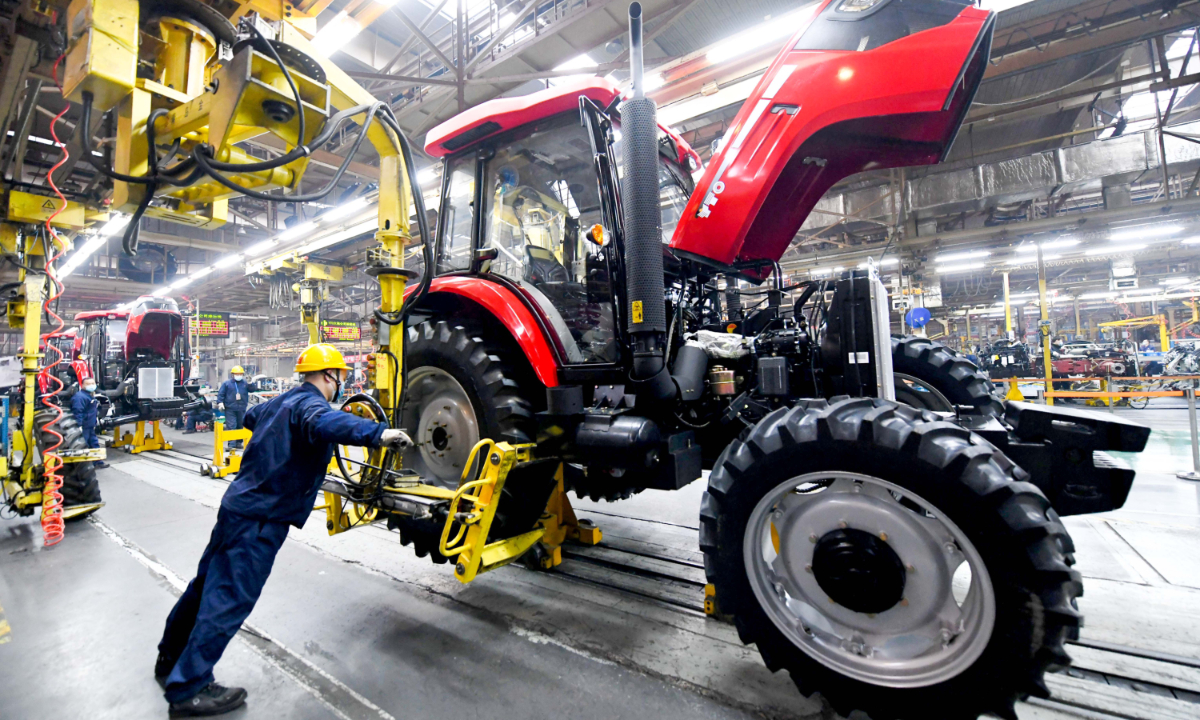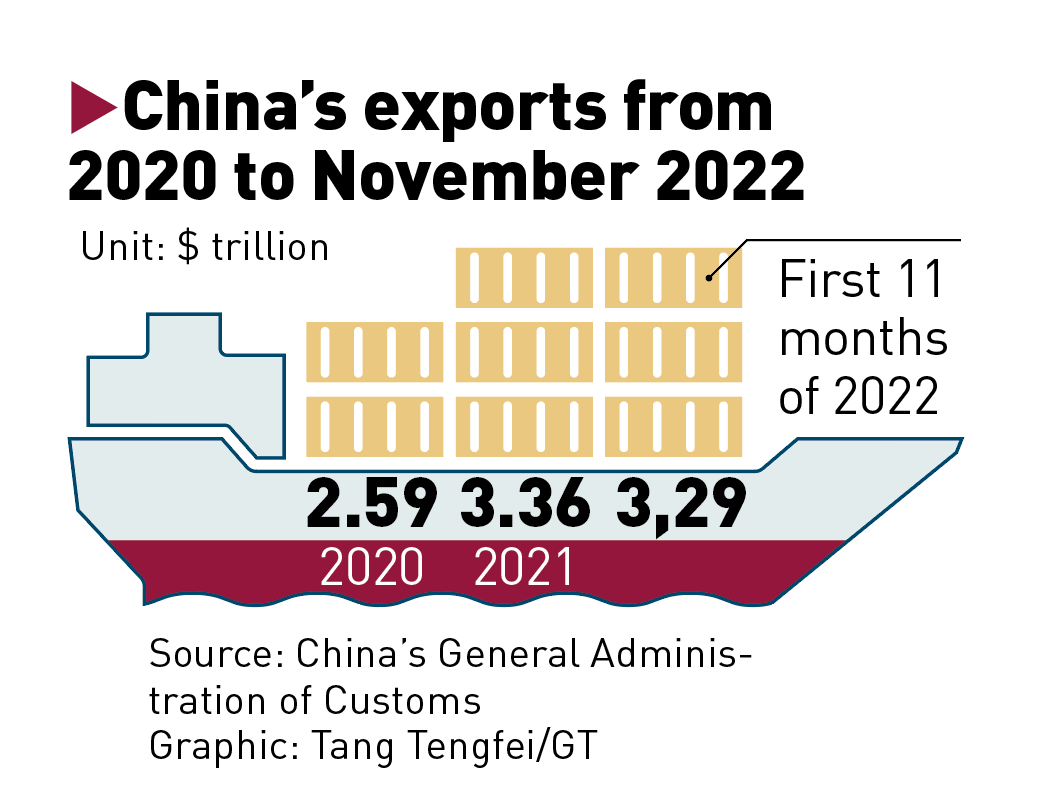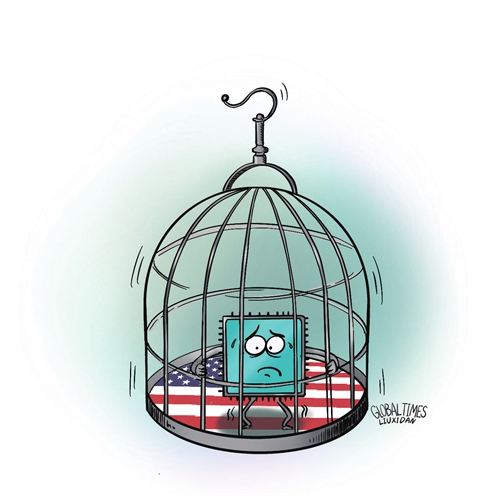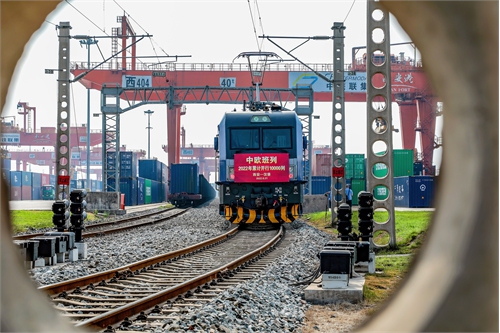Chinese ingenuity, diligence ensure ‘Made-in-China’ irreplaceable during pandemic
Special report: How China kept its export engine room roaring over the past three years
Editor's Note:
China on December 7 further optimized its anti-COVID-19 measures, ushering in a new chapter in the response to the pandemic. While the lifting of restrictions boosted confidence allowing for a rapid economic recovery, some foreign media outlets have taken every opportunity to attack China's anti-COVID measures and economy. To debunk claims of a looming "China collapse," the Global Times is publishing a three-part series to illustrate how Chinese ingenuity and diligence has not only kept exports, investment and consumption - three main pillars of the Chinese economy - strong over the past three years but also ensured the country's long-term development despite challenges. This is the first article focusing on how Chinese firms and officials worked to keep the export machine roaring.

In the early days of the COVID-19 pandemic, as production halted and supply chains fractured, He Guohua, who had been engaged in the production and export of stationery for over 10 years, thought the virus would destroy his business. But three years later, his business not only survived but has actually emerged stronger.
"Back to three years ago, I didn't dare to imagine that our company could not only navigate the prolonged pandemic but make successful transformation to become an overseas well-known brand," He Guohua, manager of Yiwu-based stationery exporter Motarro, told the Global Times.
As he knows firsthand, that this outcome did not come easily. He had to deal with a series of challenges over the past three years, ranging from suspended production, supply chain bottlenecks as well as weak demand. He had to be creative in the whole process, from transforming his business to finding new ways to engage overseas clients and actively explore fresh markets.
His story encapsulates the tenacity and swift response of local officials and hundreds of thousands of manufacturers in Yiwu, the world's largest commodities hub, located in East China's Zhejiang Province, in dealing with challenges and risks.
This is also the story of how Chinese ingenuity, diligence and adaptability not only ensured sufficient supply of everything from medical supplies to daily necessities to a world in crisis, but also paved the way for stronger development in the years and even decades ahead.
While many foreign media outlets have taken every chance to attack China's anti-epidemic measures and its impact on the economy, some foreign governments even trying to shut down China's export sector with various protectionist moves, China's export machine has kept roaring.
Sparing no effort
For the past three years, China spared no effort to stabilize foreign trade and made great contribution to the world by exporting an array of products from urgently needed anti-pandemic goods and daily necessities to warm clothing and heating appliances amid Western energy crisis and World Cup-related merchandise.
China's effective coordination of epidemic prevention and control with economic and social development as well as the solid foundation of complete industrial system helped the country swiftly emerge from a pandemic-induced slump in early 2020, underscoring the global competitiveness of "made-in-China" and the country's irreplaceable status throughout global industrial and supply chains.
Prior to the first COVID-19 outbreak, He's company was an original equipment manufacturer that has been engaged in the production of stationery for over 10 years, but the pandemic almost destroyed his business. "Our production was normal at the beginning of 2020 thanks to sufficient overseas orders we won in 2019, but our foreign clients asked us to delay shipments week by week when overseas outbreak deteriorated starting in March," He said.
He said he was very anxious then because the 30-person factory would face losses of tens of millions of yuan as the pens, adhesive bands and writing cases were nearing their expiration date sitting idle in his warehouses.
"Thus, we decided to develop an independent brand in June 2020 to take the initiative," He said, recalling that the company came up with a variety of difficulties to outshine its competitors in many overseas markets.
"For example, although overseas countries gradually emerged from lockdown in June 2020, overseas clients could not come back to Yiwu due to suspended international flights. Therefore, we stepped up exchanges with clients online and conducted marketing to our overseas audience via TikTok, Facebook and YouTube," he said, noting that the good quality and strong cost performance of its products also helped bring new clients.
Starting from scratch, the brand saw its revenue hit around 50 million yuan ($7.17 million) so far this year, from around 27 million yuan in 2021. Currently, the company has more than 180 dealers in over 60 countries in regions including Europe, Southeast Asia, the Middle East, and Africa. "The number of our workers doubled to over 60 now, and we continue to hire talent," He said, showing strong confidence for sustainable growth in the future.
He's story is a microcosm of Yiwu's efforts to stabilize its export sector during the pandemic. Over the past three years, the city's exports reported continuous growth. Even amid mounting external uncertainties, Yiwu's exports jumped 19.1 percent year-on-year to 399.1 billion yuan in the first 11 months of 2022, data from local customs showed.
Around two thirds of Christmas goods and 70 percent of World Cup-related products were sourced from Yiwu. As Europe enters a cold winter struggling with an energy shortage, Yiwu's exports of woolen sweaters, warm leggings and electric heaters have also surged.
As of December 4, more than 1,500 trips were run by "Yiwu-Xinjiang-Europe" China-Europe freight trains this year, sending 124,000 standard containers of goods from Yiwu, up 26 percent year-on-year, data from local government showed.
As a barometer of China's overall export situation, the sound performance of Yiwu reflects the steady expansion of China's foreign trade since the beginning of COVID-19.
Thanks to its most complete industrial chains, China's exports made up for those from pandemic-inflicted economies. The country's share in global total exports increased to 14.7 percent in 2020, up 1.5 percentage points compared with the previous year, data from the General Administration of Customs (GAC) showed.
In 2021, the value of the country's exports grew by 29.9 percent year-on-year, and its share in global total reached 15.1 percent, both reaching new historic highs, according to the GAC.
Over the past three years, China donated more than 2.2 billion doses of vaccines to over 120 countries and international organizations, and supplied and exported anti-pandemic items to more than 200 countries and regions, official data showed.
While transport and trade across the world was severely affected due to the pandemic, China's modern transport network comprised of roads, railway, flight and ocean shipping forms an efficient logistics network that services the globe. The Ningbo-Zhoushan Port, one of the world's busiest ports in terms of cargo throughput, registered year-on-year cargo and container growth of 3.41 percent and 7.84 percent in the first 11 months of 2022, according to official data.
Meng Wei, a spokesperson from the National Development and Reform Commission, told reporters in May that the number of train the China-Europe Express Railway handled each month topped 1,000 for a consecutive of 24 months since the COVID-19 outbreak, playing a vital role in stabilizing global industrial and supply chains.
Throughout the pandemic, the Chinese authorities announced several rounds of support policies to stabilize foreign trade, including fiscal and financial support, unclogging logistics, encouraging cross-border e-commerce and holding a series of online and offline exhibitions like the China International Import Expo to help foreign trade companies navigate headwinds.
In particular, the Regional Comprehensive Economic Partnership (RCEP) took effect in January, and not only brings convenience to foreign trade but directly leads to lower tariffs. In the first 11 months of 2022, China's foreign trade with Belt and Road Initiative (BRI) countries and other RCEP members grew by 20.4 percent year-on-year and 7.9 percent year-on-year, respectively.

Bright prospect
Looking into the future, industry insiders and experts are positive about the prospects for China's export sector in 2023, despite mounting external challenges and uncertainties in a complex and volatile international environment.
Although challenges for China's export sector persist in 2023, for instance, unprecedented US-led crackdown, soaring inflation across the world, as well as the localization of global supply chains and anti-globalization trend, the country's advantage of the most complete industrial system worldwide will support the resilience of its exports, according to Lian Ping, chief economist and head of the Zhixin Investment Research Institute.
Under the most optimistic scenario, China's exports are forecast to grow by around 8 percent year-on-year in 2023, as interest rate hikes across the world recede, global inflation falls and the impact of pandemic controls on the manufacturing sector further declines, Lian told the Global Times.
Lian anticipated that the export of China's traditional industrial products such as integrated circuits and machinery component to the ASEAN may continue to grow due to favorable tariffs under the RCEP framework, while the relocation of EU manufacturing abroad will provide opportunities for China's chemical, transport equipment and machinery manufacturing.
"The export of new energy products such as electric vehicles (EV), photovoltaic product and batteries may show outstanding performance in 2023," Lian said.
According to the General Administration of Customs, China exported 12.47 trillion yuan worth of machinery products in the first 11 months of 2022, up 8.4 percent on a yearly basis. The country's export of electric vehicles, lithium batteries and solar cells jumped 128 percent, 86.6 percent and 74.3 percent, respectively. That's an epitome of the transformation of China's export-oriented industry from labor-intensive products to high-tech products during the past 10 years.
In addition, China has stepped up efforts to foster industrial clusters in strategic sectors such as next-generation electronic information, automobiles and smart home appliances since 2020, which will make it hard for other countries to replace made-in-China products.
Officials said at the annual Central Economic Work Conference held in Beijing from Thursday to Friday that China will make greater efforts to stabilize the scale of foreign trade and optimize its structure, attract and utilize foreign capital and nurture new growth points for international economic and trade cooperation, the Xinhua News Agency reported.
China will actively seek to join the high-standard economic and trade agreements such as the Comprehensive and Progressive Agreement for Trans-Pacific Partnership and the Digital Economy Partnership Agreement, the meeting said.
Recently, many localities across China have moved quickly to boost foreign trade, and regional economic powerhouses including East China's Zhejiang and Jiangsu provinces, South China's Guangdong Province and Southwest China's Sichuan Province have organized business delegations to seek out orders overseas, after the optimization of COVID-19 response measures.
Ningbo New Oriental Electric Industrial Development is a company that joined a business delegation to Dubai. Zhu Qiucheng, CEO of the company, told the Global Times on Saturday that many businessmen that recently traveled overseas have come back with new deals and renewed confidence.
"Compared with winning new orders, the action has a more important meaning of boosting confidence," Zhu said. "It will not only lift the confidence of Chinese enterprises but also that of our overseas clients through face-to-face visits and negotiation," he said.
"Markets along the BRI and RCEP will become our priority," he said.
China on December 7 further optimized its anti-COVID-19 measures, ushering in a new chapter in the response to the pandemic. While the lifting of restrictions boosted confidence allowing for a rapid economic recovery, some foreign media outlets have taken every opportunity to attack China's anti-COVID measures and economy. To debunk claims of a looming "China collapse," the Global Times is publishing a three-part series to illustrate how Chinese ingenuity and diligence has not only kept exports, investment and consumption - three main pillars of the Chinese economy - strong over the past three years but also ensured the country's long-term development despite challenges. This is the first article focusing on how Chinese firms and officials worked to keep the export machine roaring.

Wokers assemble tractors for export in Luoyang, Central China's Henan Province. Photo: VCG
In the early days of the COVID-19 pandemic, as production halted and supply chains fractured, He Guohua, who had been engaged in the production and export of stationery for over 10 years, thought the virus would destroy his business. But three years later, his business not only survived but has actually emerged stronger.
"Back to three years ago, I didn't dare to imagine that our company could not only navigate the prolonged pandemic but make successful transformation to become an overseas well-known brand," He Guohua, manager of Yiwu-based stationery exporter Motarro, told the Global Times.
As he knows firsthand, that this outcome did not come easily. He had to deal with a series of challenges over the past three years, ranging from suspended production, supply chain bottlenecks as well as weak demand. He had to be creative in the whole process, from transforming his business to finding new ways to engage overseas clients and actively explore fresh markets.
His story encapsulates the tenacity and swift response of local officials and hundreds of thousands of manufacturers in Yiwu, the world's largest commodities hub, located in East China's Zhejiang Province, in dealing with challenges and risks.
This is also the story of how Chinese ingenuity, diligence and adaptability not only ensured sufficient supply of everything from medical supplies to daily necessities to a world in crisis, but also paved the way for stronger development in the years and even decades ahead.
While many foreign media outlets have taken every chance to attack China's anti-epidemic measures and its impact on the economy, some foreign governments even trying to shut down China's export sector with various protectionist moves, China's export machine has kept roaring.
Sparing no effort
For the past three years, China spared no effort to stabilize foreign trade and made great contribution to the world by exporting an array of products from urgently needed anti-pandemic goods and daily necessities to warm clothing and heating appliances amid Western energy crisis and World Cup-related merchandise.
China's effective coordination of epidemic prevention and control with economic and social development as well as the solid foundation of complete industrial system helped the country swiftly emerge from a pandemic-induced slump in early 2020, underscoring the global competitiveness of "made-in-China" and the country's irreplaceable status throughout global industrial and supply chains.
Prior to the first COVID-19 outbreak, He's company was an original equipment manufacturer that has been engaged in the production of stationery for over 10 years, but the pandemic almost destroyed his business. "Our production was normal at the beginning of 2020 thanks to sufficient overseas orders we won in 2019, but our foreign clients asked us to delay shipments week by week when overseas outbreak deteriorated starting in March," He said.
He said he was very anxious then because the 30-person factory would face losses of tens of millions of yuan as the pens, adhesive bands and writing cases were nearing their expiration date sitting idle in his warehouses.
"Thus, we decided to develop an independent brand in June 2020 to take the initiative," He said, recalling that the company came up with a variety of difficulties to outshine its competitors in many overseas markets.
"For example, although overseas countries gradually emerged from lockdown in June 2020, overseas clients could not come back to Yiwu due to suspended international flights. Therefore, we stepped up exchanges with clients online and conducted marketing to our overseas audience via TikTok, Facebook and YouTube," he said, noting that the good quality and strong cost performance of its products also helped bring new clients.
Starting from scratch, the brand saw its revenue hit around 50 million yuan ($7.17 million) so far this year, from around 27 million yuan in 2021. Currently, the company has more than 180 dealers in over 60 countries in regions including Europe, Southeast Asia, the Middle East, and Africa. "The number of our workers doubled to over 60 now, and we continue to hire talent," He said, showing strong confidence for sustainable growth in the future.
He's story is a microcosm of Yiwu's efforts to stabilize its export sector during the pandemic. Over the past three years, the city's exports reported continuous growth. Even amid mounting external uncertainties, Yiwu's exports jumped 19.1 percent year-on-year to 399.1 billion yuan in the first 11 months of 2022, data from local customs showed.
Around two thirds of Christmas goods and 70 percent of World Cup-related products were sourced from Yiwu. As Europe enters a cold winter struggling with an energy shortage, Yiwu's exports of woolen sweaters, warm leggings and electric heaters have also surged.
As of December 4, more than 1,500 trips were run by "Yiwu-Xinjiang-Europe" China-Europe freight trains this year, sending 124,000 standard containers of goods from Yiwu, up 26 percent year-on-year, data from local government showed.
As a barometer of China's overall export situation, the sound performance of Yiwu reflects the steady expansion of China's foreign trade since the beginning of COVID-19.
Thanks to its most complete industrial chains, China's exports made up for those from pandemic-inflicted economies. The country's share in global total exports increased to 14.7 percent in 2020, up 1.5 percentage points compared with the previous year, data from the General Administration of Customs (GAC) showed.
In 2021, the value of the country's exports grew by 29.9 percent year-on-year, and its share in global total reached 15.1 percent, both reaching new historic highs, according to the GAC.
Over the past three years, China donated more than 2.2 billion doses of vaccines to over 120 countries and international organizations, and supplied and exported anti-pandemic items to more than 200 countries and regions, official data showed.
While transport and trade across the world was severely affected due to the pandemic, China's modern transport network comprised of roads, railway, flight and ocean shipping forms an efficient logistics network that services the globe. The Ningbo-Zhoushan Port, one of the world's busiest ports in terms of cargo throughput, registered year-on-year cargo and container growth of 3.41 percent and 7.84 percent in the first 11 months of 2022, according to official data.
Meng Wei, a spokesperson from the National Development and Reform Commission, told reporters in May that the number of train the China-Europe Express Railway handled each month topped 1,000 for a consecutive of 24 months since the COVID-19 outbreak, playing a vital role in stabilizing global industrial and supply chains.
Throughout the pandemic, the Chinese authorities announced several rounds of support policies to stabilize foreign trade, including fiscal and financial support, unclogging logistics, encouraging cross-border e-commerce and holding a series of online and offline exhibitions like the China International Import Expo to help foreign trade companies navigate headwinds.
In particular, the Regional Comprehensive Economic Partnership (RCEP) took effect in January, and not only brings convenience to foreign trade but directly leads to lower tariffs. In the first 11 months of 2022, China's foreign trade with Belt and Road Initiative (BRI) countries and other RCEP members grew by 20.4 percent year-on-year and 7.9 percent year-on-year, respectively.

Graphic: Tang Tengfei/GT
Bright prospect
Looking into the future, industry insiders and experts are positive about the prospects for China's export sector in 2023, despite mounting external challenges and uncertainties in a complex and volatile international environment.
Although challenges for China's export sector persist in 2023, for instance, unprecedented US-led crackdown, soaring inflation across the world, as well as the localization of global supply chains and anti-globalization trend, the country's advantage of the most complete industrial system worldwide will support the resilience of its exports, according to Lian Ping, chief economist and head of the Zhixin Investment Research Institute.
Under the most optimistic scenario, China's exports are forecast to grow by around 8 percent year-on-year in 2023, as interest rate hikes across the world recede, global inflation falls and the impact of pandemic controls on the manufacturing sector further declines, Lian told the Global Times.
Lian anticipated that the export of China's traditional industrial products such as integrated circuits and machinery component to the ASEAN may continue to grow due to favorable tariffs under the RCEP framework, while the relocation of EU manufacturing abroad will provide opportunities for China's chemical, transport equipment and machinery manufacturing.
"The export of new energy products such as electric vehicles (EV), photovoltaic product and batteries may show outstanding performance in 2023," Lian said.
According to the General Administration of Customs, China exported 12.47 trillion yuan worth of machinery products in the first 11 months of 2022, up 8.4 percent on a yearly basis. The country's export of electric vehicles, lithium batteries and solar cells jumped 128 percent, 86.6 percent and 74.3 percent, respectively. That's an epitome of the transformation of China's export-oriented industry from labor-intensive products to high-tech products during the past 10 years.
In addition, China has stepped up efforts to foster industrial clusters in strategic sectors such as next-generation electronic information, automobiles and smart home appliances since 2020, which will make it hard for other countries to replace made-in-China products.
Officials said at the annual Central Economic Work Conference held in Beijing from Thursday to Friday that China will make greater efforts to stabilize the scale of foreign trade and optimize its structure, attract and utilize foreign capital and nurture new growth points for international economic and trade cooperation, the Xinhua News Agency reported.
China will actively seek to join the high-standard economic and trade agreements such as the Comprehensive and Progressive Agreement for Trans-Pacific Partnership and the Digital Economy Partnership Agreement, the meeting said.
Recently, many localities across China have moved quickly to boost foreign trade, and regional economic powerhouses including East China's Zhejiang and Jiangsu provinces, South China's Guangdong Province and Southwest China's Sichuan Province have organized business delegations to seek out orders overseas, after the optimization of COVID-19 response measures.
Ningbo New Oriental Electric Industrial Development is a company that joined a business delegation to Dubai. Zhu Qiucheng, CEO of the company, told the Global Times on Saturday that many businessmen that recently traveled overseas have come back with new deals and renewed confidence.
"Compared with winning new orders, the action has a more important meaning of boosting confidence," Zhu said. "It will not only lift the confidence of Chinese enterprises but also that of our overseas clients through face-to-face visits and negotiation," he said.
"Markets along the BRI and RCEP will become our priority," he said.



